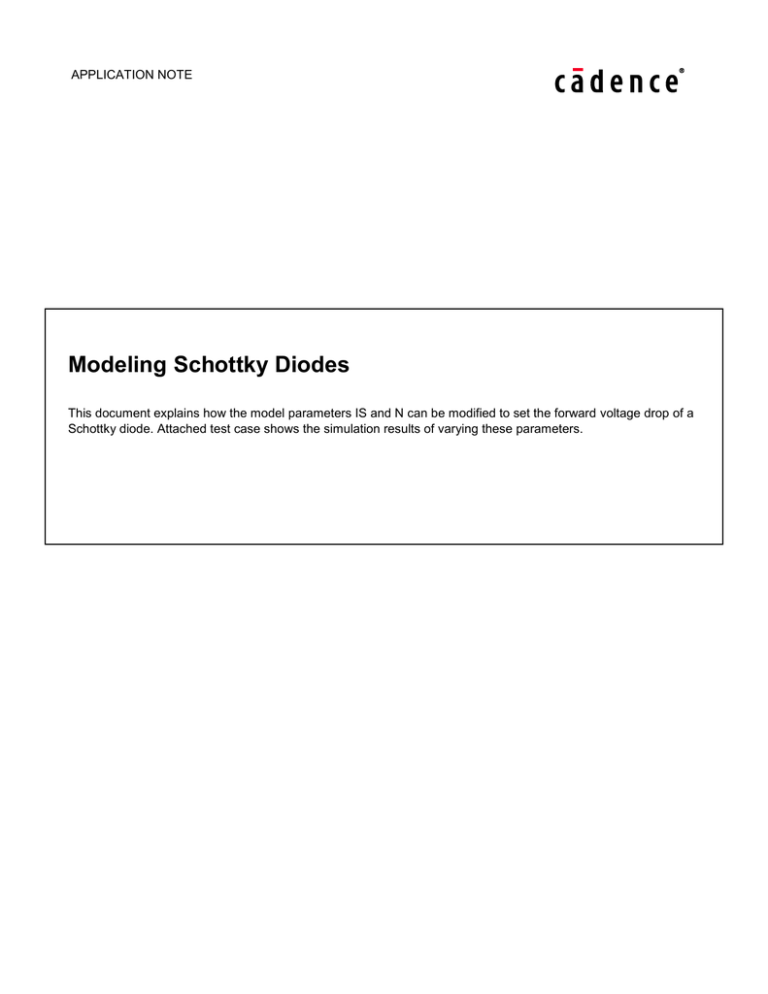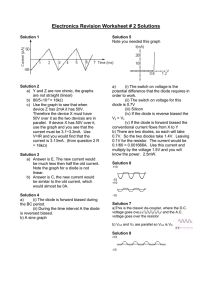
APPLICATION NOTE
Modeling Schottky Diodes
This document explains how the model parameters IS and N can be modified to set the forward voltage drop of a
Schottky diode. Attached test case shows the simulation results of varying these parameters.
Introduction
This document explains how the model parameters IS and N can be modified to set the forward voltage drop of a
Schottky diode. Attached test case shows the simulation results of varying these parameters. The project has
three simulation profiles;
1. dc: DC sweep analysis of forward biased schottky diode as shown in Fig. 2.
2. IS_Variation: Nested DC sweep. Shows effect of IS variation.
3. N_Variation: Nested DC sweep. Shows effect of N variation.
Schottky Diode
Schottky diode, also known as hot carrier diode is a semiconductor diode with low forward voltage and a very fast
switching action. Unlike a PN-junction diode, a Schottky Diode has a metal–semiconductor (M–S) junction in
which a metal comes in close contact with a semiconductor material. Schottky diodes do not have a recovery
time, as there is nothing to recover from (i.e. no charge carrier depletion region at the junction). The switching
time is ~100 ps for the small signal diodes, and up to tens of nanoseconds for special high-capacity power diodes.
(1)
(2)
Where
Developing Model
With respect to the above diode equation, we can see that the forward voltage drop, V, depends on the
current, I, but only weakly. V increases by 60 millivolts for each factor of 10 that I increases. Alternatively, V
increases by 60 millivolts for each factor of 10 that IS decreases. So, the forward voltage drop for your
circuit’s bias conditions can be set by changing IS parameter. You can change this in the diode’s .MODEL
statement. For Schottky diodes, values of IS are larger when compared to diffusion diodes of the same
area. The model parameter N can also be used to adjust the forward voltage drop, but changing N will make
the I-V curve deviate from the normal slope of a decade per 60 millivolts. We do not recommend changing N
1
APPLICATION NOTE
in order to model Schottky diodes. The attached test case shows the effect with DC sweep of IS and N
parameters.
Simulation of schottky diode, Dmurs360t3
Fig. 1 and 2 show the circuit and the model being used for this simulation.
Figure 1: Circuit diagram in Allegro Design Entry CIS (Capture CIS)
Figure 2: PSpice Model parameters
Do a DC sweep of above circuit, sweeping V1 linearly from 0.1 to 3.5 with an increment of 0.001. Fig. 3 shows the
simulation results. Value of IS is 3e-07 and N is 2.2.
2
APPLICATION NOTE
Figure 3: Simulation results – IS=3e-07, N=2.2
Effect of varying Parameter ‘IS’
DC nested sweep is done to vary the Model parameter 'IS'. Secondary sweep is done for IS values of 3e-04, 3e06 and 3e-08. Simulate profile ‘IS_variation’ in attached test case.
Figure 4: Simulation setting for DC nested sweep- varying model parameter IS
3
APPLICATION NOTE
Fig. 5 shows the effect of varying IS parameter. You can see that as IS decreases, for the same Forward Current
(I) we get greater Forward bias Voltage (V).
Figure 5: Effect of varying IS parameter value for a schottky diode
Effect of varying Parameter ‘N’
DC nested sweep is done to vary the Model parameter 'N'. Secondary sweep is done for N values of 2.2, 2.4, 2.6,
2.8 and 3. Simulate profile ‘N_variation’ in attached test case.
Figure 4A: Simulation setting for DC nested sweep- varying model parameter N
4
APPLICATION NOTE
Fig. 7 shows the effect of varying N parameter. You can see that slope of the forward current changes with
changing N.
Figure 7: Effect of varying N parameter value for a schottky diode
References
[1] D. A. Hodges and H. G. Jackson, Analysis and Design of Digital Integrated Circuits, McGraw-Hill.
© Copyright 2016 Cadence Design Systems, Inc. All rights reserved. Cadence, the Cadence logo, and Spectre are registered trademarks of Cadence
Design Systems, Inc. All others are properties of their respective holders.
5
APPLICATION NOTE


